Among the nine oilseed crops grown in our country, groundnut is an important one. Other local names include earthnuts, ground nuts, goober peas, monkey nuts, pygmy nuts, and peanuts. As the groundnut crop grows, it is infested by sucking insects, such as aphids, leaf miners, thrips, leaf-eating caterpillars, etc. Pod borer pests may attack the crop, later puncturing the developing pods and causing heavy damage.
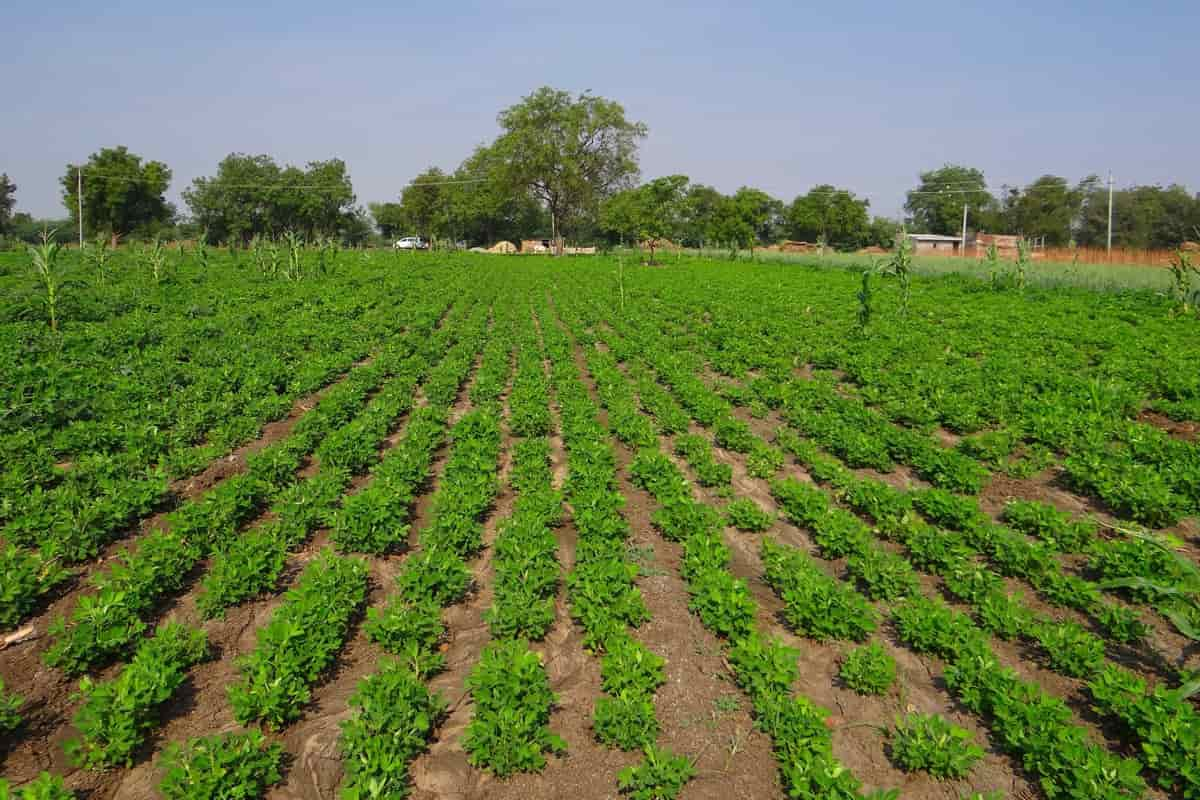
Along with these pests, the Groundnut crop is prone to attack by various diseases much larger extent than any other crop. One of the most critical factors contributing to low yield is disease attack. More than 40 pathogens and even viruses have been reported to affect groundnut. The major pests and diseases which causes significant effect on yield and crop quality and their control methods are discussed below.
Pests and diseases management in Groundnut
Pests in Groundnut crop
Ground nut Aphid
They are small (2 mm long), pear-shaped, green, greenish-brown, or greenish-black insects. Nymphs are dark brown, and adults are shiny and dark. The majority of adults lack wings, but there are some winged forms as well. Usually, two months after germination, both nymphs and adults suck sap from leaflets and tender shoots. Each year, it produces 12-14 generations. Each plant has 50-100 aphids.
Damage symptoms
- In large populations, ground nut aphids inject a powerful toxin into plants, causing stunting or death.
- While feeding, these aphids will produce a considerable amount of honeydew on which sooty mold grows. Leaves may become unpalatable to livestock due to the black sooty mold, which reduces photosynthesis.
- Yellowing, wilting, and dieback are all symptoms of damage.
- The Rossette & Peanut strip virus and other insect-borne diseases can seriously damage legumes directly or indirectly.
Biological control and management
- Treatment of seeds with Trichoderma viride at a rate of 4 grams per kilogram is recommended.
- The use of NSKE 5% (neem seed kernel extract) is recommended for the control of sucking pests.
- Augment the release of Cheilonenes sexmaculata at 1250 per hectare.
- Conserve bio-agents like flower bugs, ladybird beetles, praying mantis, hoverflies, green lacewing, long-horned grasshoppers, and spiders.
Chemical control
- Apply any one of the following insecticides
- Chlorpyrifos 20%EC 1000 ml/ha
- Imidacloprid 17.8% SL 100-125 ml/ha
- Methyl demeton 25% EC 1000 ml/ha
Jassids
It is a small greenish-colored insect. Jassids are also known as Leaf Hoppers Adults. As soon as the plant canopy is disturbed, jassids fly away. Near the midrib or petiole, the eggs are inserted into the leaf tissue. It takes a week for the eggs to hatch and ten days for the nymphs to become adults. During August and September, as well as February and March, there is a high infestation. Jassid reproduction is encouraged by high rainfall and low temperatures.
In case you missed it: Best Fertilizer for Groundnut: Organic, NPK, Compost Manure, and Schedule
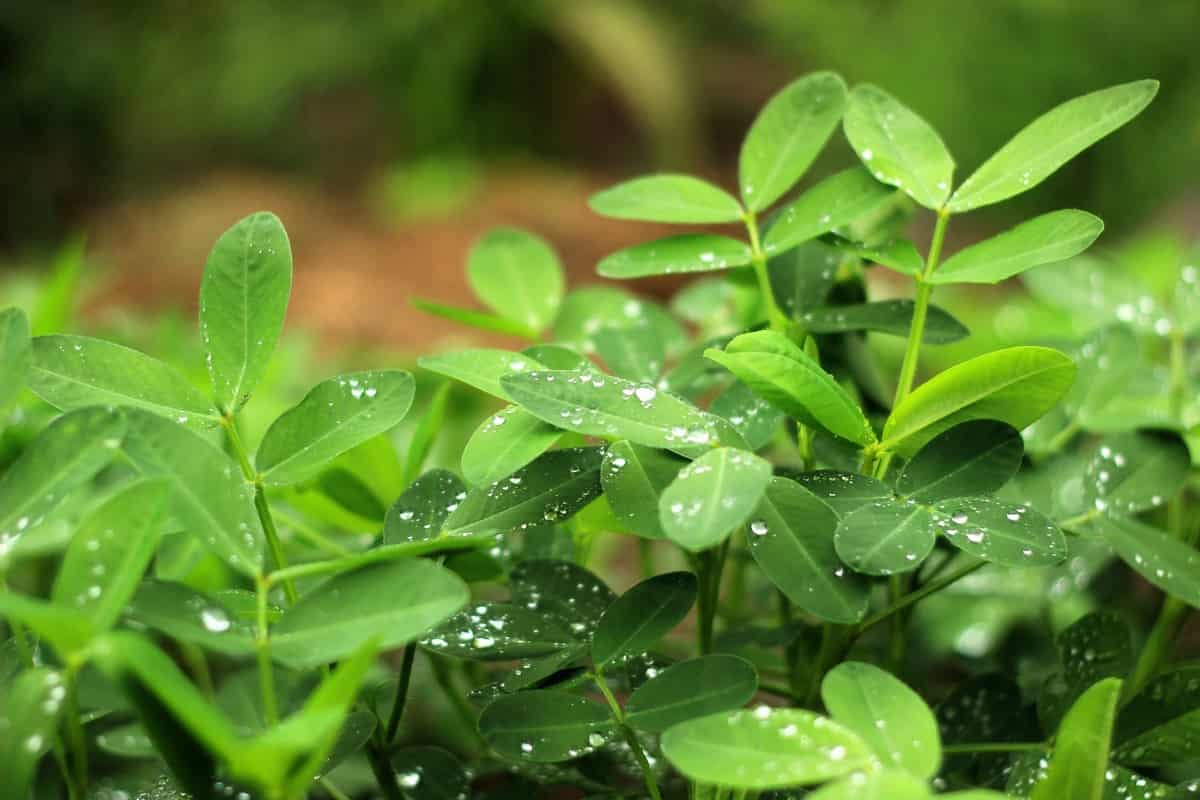
Damage symptoms
- It suckers sap from young leaves, mainly from their lower surfaces, both as adults and as nymphs. A whitening of the veins is the first symptom of an attack. As a result, yellow patches appear on leaflets, especially at their tips.
- As the leaf tips become necrotic, the crop appears scorched and scorched, creating a characteristic ‘v’ shape. Eggs are inserted into leaf tissue close to the midrib or petiole.
- It takes one week for the egg to hatch and ten days for the nymphs to become adults. In August and September, as well as February and March, there is a high incidence of infestation.
Biological control and management
- Conserve bio-agents like praying mantis, long-horned grasshoppers, dragonflies, spiders, and green muscardine fungus.
- Timely sow of the crop and field sanitation
- Grow tolerant varieties like Girnar and crop rotation with nonhost crops.
- Intercropping with pearl millet, Avoid groundnut-castor inter-crop; it increases the infestation.
- Irrigate once to avoid prolonged mid-season drought to prevent pre-harvest.
- The affected parts of the plant should be collected and destroyed
Chemical control
When the insect population crosses the ETL, apply safe chemical insecticides at recommended doses. Dimethoate 30EC or monocrotophos 36SL can be sprayed at 650 ml/ha and 600 ml/ha, respectively.
Thrips
It is about 10 millimeters long, pale cream color, and hidden. The eggs are laid into the young tissues of the plant. The nymphs become adults after 15 days through four instars. Pest activity and presence increase during high temperatures with low rainfall. The pest is known to transmit the virus for bud necrosis; hence monitor for symptoms of bud necrosis.
Damage symptoms
- Consequently, young leaves are distorted, and white patches appear on their lower surfaces due to larval, adult laceration, and sap-sucking.
- Plants with severe infestations become stunted.
- Thrips palmi transmits peanut bud necrosis.
Biological control and management
- Conserve bio-agents like flower bugs, ladybird beetles, praying mantis, green lacewings, long-horned grasshoppers, dragonflies, and spiders.
- Plant varieties with high tolerance, such as ALR 3, Kadiri 3, Robut 33-1, and ICGS 86031
- Several groundnut accessions are resistant to thrips, including 21018.
Chemical control
- Use Monochrotophos 36 SL 600 ml/ha, Dimethoate 30 EC 650 ml per hectare, or Methyldemeton 25 EC 600 ml in 600 liters.
- In 200 liters of water, spray monocrotophos 320 ml mixed with neem oil and 1 kg soap powder twice every ten days.
Leaf miner
Leaf miner larvae cause damage to the groundnut. The eggs of the leaf miner are shiny white and are laid singly on the lower side of the leaflets, while the larvae are light green or brown with a dark head and prothorax. The adult leaf miner is a tiny moth that measures about 6 mm in length. Its wings are brownish-gray in color. White dots also exist on each forewing of the adult. The larvae mine the leaves and feed inside the leaflet. Mined areas in the leaf become dry. The leaf miners are active both in rainy and post-rainy seasons, and crop losses can vary from 25% to 75%.
In case you missed it: Ways Groundnut Farming Can Make You Rich in Short Time
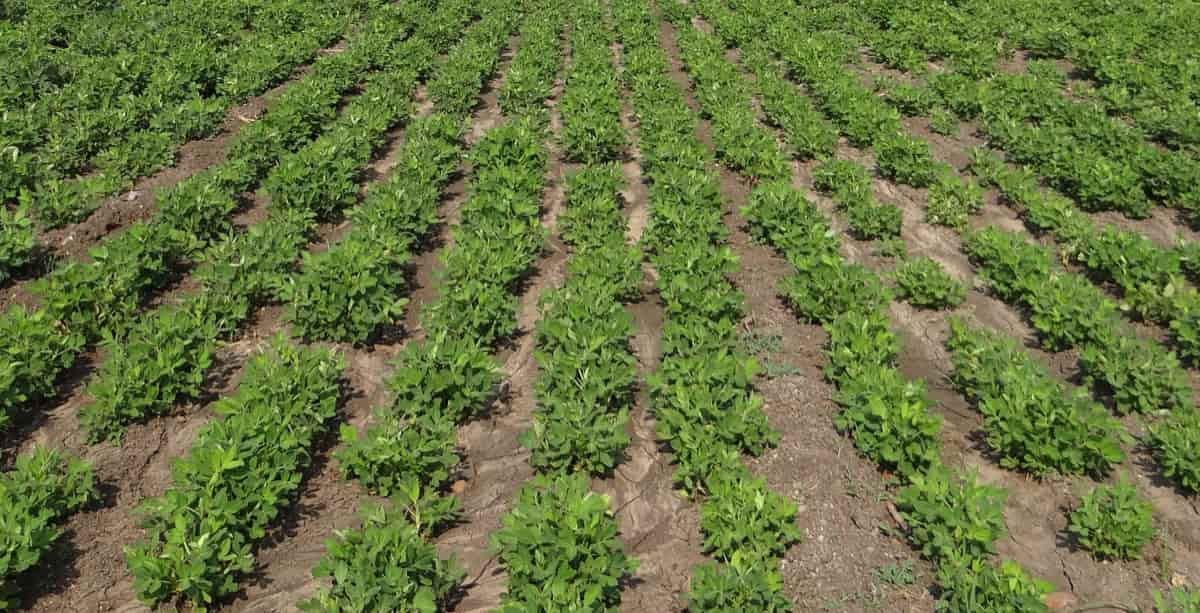
Damage symptoms
- Small blister-like mines are seen on the upper leaf surface near mid-rib.
- During feeding, the mines become larger, and the leaflet turns brown, fades, and dries.
- A burnt-up appearance can be seen in severe cases of the disease.
- A larva feeds on the leaflets in the later stages of development, remaining within the folds of the leaflets.
Biological control and management
- Rotating non-leguminous crops would greatly reduce leafminer populations.
- Groundnuts should not be rotated with soybeans or other leguminous crops.
- Using resistant/tolerant varieties would be the most promising control method.
Chemical control
- Chemical sprays are only recommended when at least five larvae per plant at the seedling stage 30 days after emergence (DAE), ten larvae at the flowering stage (50 DAE), and 15 larvae per plant at the pod-filling stage (70 DAE) is noticed.
- Apply a chemical spray with dimethoate at 200-250 ml/ha (Chlorpyrifos at 2.5 ml/l or Acephate at 1.5 g/l) or Profenofos 20 EC at 2 ml per liter between 30-45 days after sowing, if the pest populations are above the economic threshold level.
- Apply Monocrotophos 0.04 %, Fenitrothion 0.05 %, Endosulfan 0.07 %, Carbaryl 0.2 %, and Quinalphos 0.05 %.
Gram pod borer
An adult is a brown-colored moth with A V-shaped speck on the forewings and a dull black border on the hind wing. Eggs are laid singly on the host plant. The egg period is 5-7 days. The larva is greenish with dark brown to grey lines. Color varies with the kind of host plant. The larval period is 14-20 days. It pupates in soil, and the pupal stage lasts for ten days. Cannibalism is common among larvae.
Damage symptoms
- A larva feeds on foliage and prefers buds and flowers. When leaflets unfold after being eaten, symmetrical holes or cuttings can be seen.
- Small or large irregular holes will form due to feeding on the leaves.
- The caterpillars are pale green, rose-colored, brown, or chocolate-colored, with hair on the body and dorsal and lateral stripes. Caterpillars also damage the fruiting bodies by entering into them.
Biological control and management
- Trichogramma chilonis at 1 lakh/ha or Chrysoperla carnea at 50000/ha at 40 and 50 days after groundnut sowing can effectively check the pest.
- Apply H-NPV at 250 LE/ha or Bacillus thuringiensis 1 kg/ha or 5% NSKE.
- Conserve the natural biocontrol population of spiders, long-horned grasshoppers, praying mantis, robar fly, ants, green lacewing, damsel flies/dragonflies, flower bugs, shield bugs, ladybird beetles, ground beetle, predatory cricket, braconids, trichogrammatids, NPV, earwig and muscular green fungus.
Chemical control
- Spray endosulfan 35 EC 1000 ml or emamectin benzoate 5 SG 220 g or spinosad 45 SC 180-220 ml per ha in 375-500 L of water per hectare.
- Also, spray any one of the following insecticides
- Quinolphos 2ml/lit of water
- Chloropyriphos 3ml/lit of water
- Imidacloprid 2ml/lit of water
Tobacco caterpillar
The adult moth is stout with wavy white markings on the brown forewings and white hind wings with a brown patch along its margin. On the leaves, eggs are laid in groups and covered with hair. The egg period is 4-5 days. The larva is stout, cylindrical, and pale brownish with dark markings. The body may have a row of dark spots or transverse and longitudinal grey and yellow bands. When fully grown, it measures about 35-40 mm in length.
In case you missed it: Groundnut Seed Germination, Time, Temperature, Process
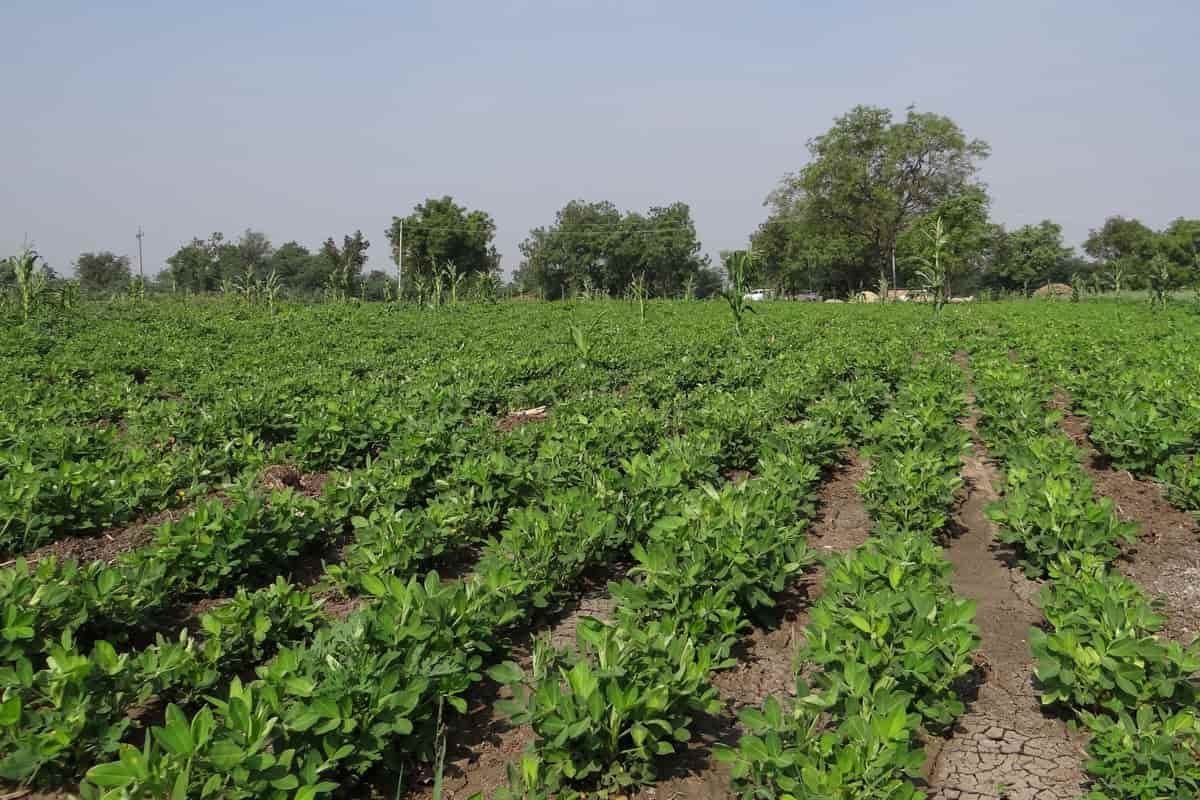
Damage symptoms
- Newly hatched larvae feed gregariously, scraping chlorophyll, and disperse soon after hatching.
- During the day, they hide in the soil around the base of the plants and feed voraciously on the foliage at night.
- In some cases, petioles and branches are all that remain after the heavy feeding. Caterpillars bore into pods in light soil.
Biological control and management
- Identify and destroy the gregarious early stages caterpillars (which manifest lace-like leaves by eating castor or sunflower plants).
- Use nuclear polyhedrosis virus at 250 LE (larval equivalents)/ha with 2.5 kg sugar/ha in the evening. The sugar acts as a stimulant and a sticker.
Chemical control
The following insecticides are effective in controlling the caterpillar’s early stages in irrigated and high-input areas:
| Chemical compound | Dosage/hectare |
| Carbaryl 10 D | 2.5 kg |
| Carbaryl 50 WP | 2 kg |
| Quinalphos 20 EC | 750 ml |
| Endosulfan 35 EC | 1 liter |
| Dichlorvos 76 WSC | 750 ml |
| Indoxacarb 14.5 SC | 250 ml |
| Spinosad 45 SC | 125 ml |
Ground nut White grub
The pest is polyphagous. The adult is 18-20 mm long and 7-9 mm wide. Dark brown adult beetles lay eggs and hide in the soil. There are white eggs that are almost round in shape. In addition to being translucent and white, the young grubs measure 5 millimeters in length. Beetles emerge from the soil three to four days after rains begin.
Biological control and management
- The field must be cleared of white grub adults by collecting and destroying them.
- Birds can pick up the grubs and destroy the pupae in areas where white grub is a persistent problem by deep plowing after harvesting the crop.
- NPV, green muscardine fungus, braconids, dragonflies, trichogrammatids, and dragonflies should be conserved.
- Install light traps with the onset of rain and count the beetles daily.
Chemical control
- If the insect population crosses the ETL, apply safe chemical insecticides at recommended doses.
- You can control white grub adults by spraying Carbaryl 50 WP at 2 grams per liter on their feeding trees, like neem, etc.
- In the first few days after the first monsoon shower, 2 ml of chlorpyriphos 20EC kills the adult beetles and eliminate root grub infestations.
- 6.5 to 12.5 ml/kg of chlorpyriphos 20 EC can be applied to seeds.
- When severe infestations occur, use phorate 10G at 10kg/ha
Diseases in Groundnut crop
Early leaf spot
Peanuts are affected by early leaf spots caused by Cercospora arachidicola, a fungal ascomycete plant pathogen. C arachidicola causes significant economic losses for the peanut industry even though all cultivars of peanuts are susceptible to peanut fungi pathogens. Early leaf spots of peanuts can drastically reduce yields, leading to the economic downturn of the peanut crop economy. Depending on disease management and treatment, annual crop losses range from less than 1% to greater than 50%.
Disease symptoms
- Peanut plants are the only plants that are infected by Cercospora arachidicola, which causes brown lesions with chlorotic rings on their stems, leaves, and petioles.
- After planting, the first macroscopic symptoms usually appear on the lower leaves’ adaxial surface.
- In addition, further damage can cause premature defoliation and even yield loss. During humid weather, lesions are covered with silvery, hair-like spores.
In case you missed it: Groundnut Cultivation Income (Peanut), Cost, Yield
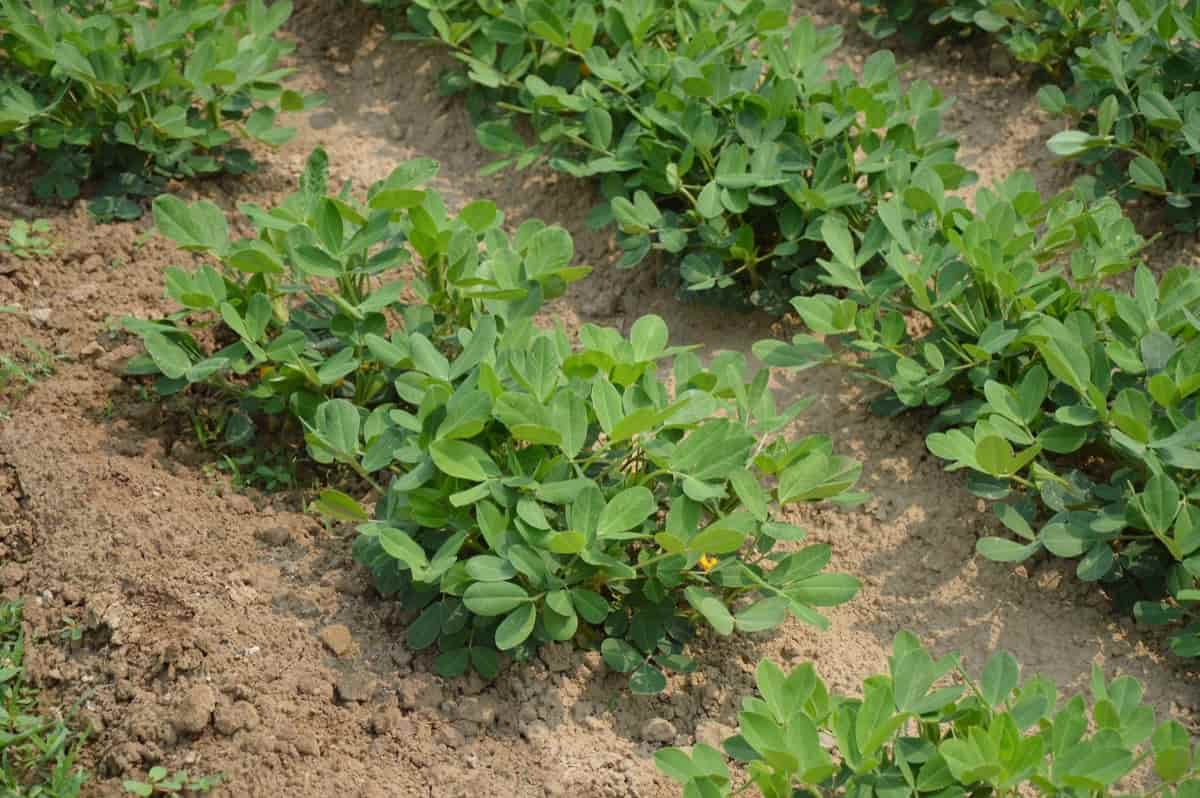
Chemical control and management
- A strip-tillage technique has also proven to delay an epidemic by reducing the initial infection incidence and severity.
- It is most effective to use resistant cultivars to overcome the pathogen and maintain yields
- Early leaf spots can be treated with fungicides such as chlorothalonil, Tebuconazole, and Pyraclostrobin applied at the early pod stage and every two weeks after that.
Yellow mold or Aflaroot disease
Aspergillus flavus causes this disease. The fungus is both seed and soil-borne. Yellow mold is commonly found to affect pods and kernels of groundnut. About 5 to 10 percent of the field seedlings showed aflaroot symptoms. Root development is reduced by infection. This symptom is known as ‘aflaroot.’
Symptoms
- The fungus rapidly reduces seeds and un-emerged seedlings to shriveled, dried, brown, or black masses covered with yellow or greenish spores.
- When infected seeds are planted, decay is most rapid.
- The emerging radicle and hypocotyl may become infected and decay rapidly in some cases.
- Diseased plants are often stunted and chlorotic under field conditions.
- In some cases, veins have been cleared, and the leaflets have been reduced in size with pointed tips and various shapes.
Chemical control and management
- Infection with A flavus is reduced by agronomic practices encouraging rapid germination and seedlings’ vigorous growth.
- Seed treatment with carbendazim at 2 g/kg seed, Captafol at 3 g/kg seed, or thiram at 3-5 g/kg seed has given good results.
Stem and pod rot
Sclerotium rolfsii Sacc causes this disease. Groundnut production can be threatened by stem and pod rot under irrigated conditions. Stem rot, southern blight, Sclerotium blight, white mold, Sclerotium rot, root rot, Sclerotium wilt, and foot rot are common names for this disease.
A yield loss of 27% or more is common in India due to the disease, which occurs sporadically. Moisture and moderate to high temperatures (25 to 35°C) promote the development of diseases. In addition to frequent rains and irrigation, dense foliage canopy increases soil moisture, causing stem rot.
Disease symptoms
- The first sign is wilting of a branch that is fully or partially in contact with the soil.
- As the leaves of the affected branch rapidly dry out, they become chlorotic and brown.
- The whole plant may die if the disease is severe or only affect two or three branches. This type of infection leads to poor pod production.
- After harvest, the pods become detached and fall to the ground.
- Young pods affected by this disease will show tan-colored lesions. The mycelial mat on severely infected pods is completely white.
- Seeds from diseased pods may show a bluish-grey discoloration known as ‘blue damage.’
Chemical control and management
- Crop sanitation should be done by burning crop residues and deep plowing before sowing.
- A crop rotation with corn, cotton, garlic, and onion minimizes soil inoculum by rotating crops.
- Treatment of seeds with carbendazim at 2 grams/kg or Trichoderma viride at 4 grams/kg.
Rust
Rust disease is caused by Puccinia arachidis Speg. Only uredial and telial stages are produced by the fungus. The uredial stage is the most prevalent and commonly observed. The pathogen perpetuates, spreads, and causes severe outbreaks through wind-borne uredospores. As a result of the contamination of seeds and pods, uredospores also spread. In addition to rain splashes, implementation also assists in dissemination. Disease development and spread are favored by high relative humidity (above 85%), heavy rainfall, and low temperatures (20°-25°C).
In case you missed it: Groundnut Oil Making Process (Peanut), Business Plan
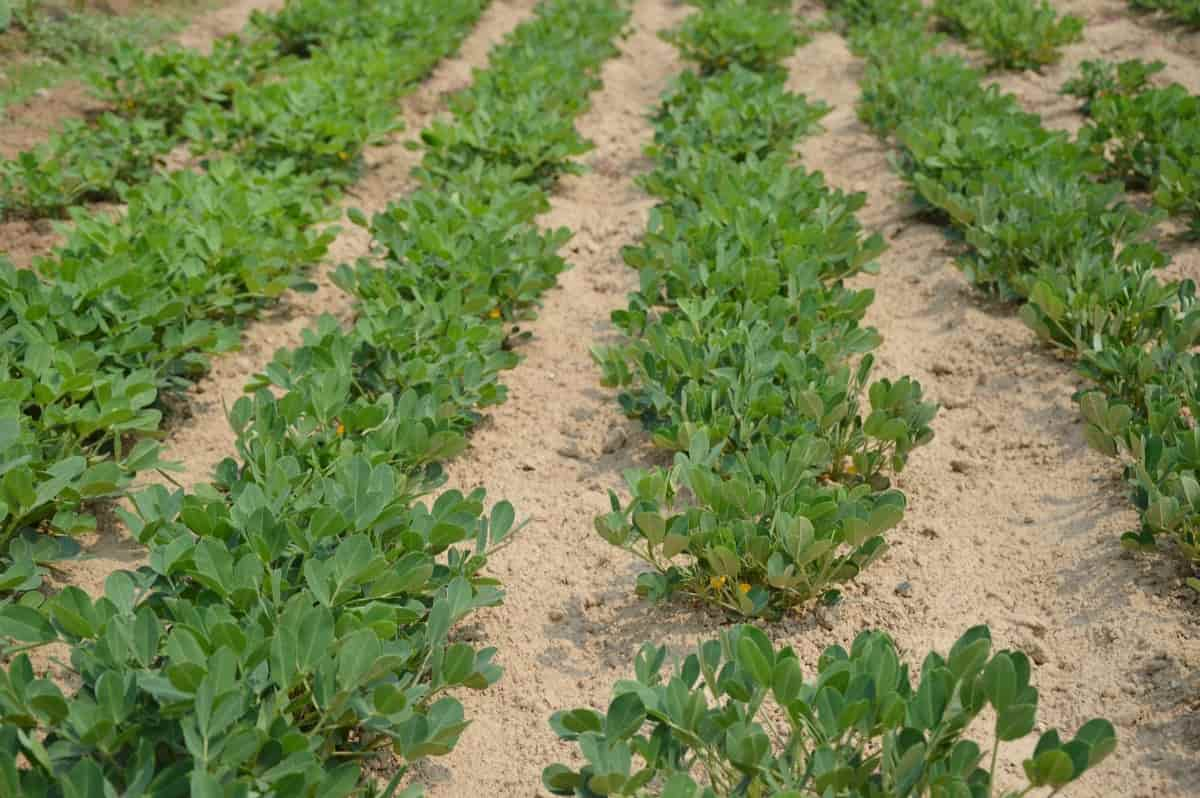
Disease symptoms
- Small brown to orange colored pustules of 0.5 to 1.4 um dia appear on the lower surface of leaves.
- The epidermis ruptures and exposes a powdery mass of reddish-brown uredospores.
- There are small, necrotic brown spots on the leaves upper surface.
- Rust pustules on the leaflets cause loss of photosynthetic tissues and lead to chlorosis and death of the whole leaflet.
- Leaflets may dry up to give the plant a burnt appearance.
- In contrast with the rapid defoliation associated with leaf spots, leaves infected with rust become necrotic and dry up but remain attached to the plant.
- The severe infection leads to the production of small and shriveled seeds.
Chemical control and management
- Volunteer groundnut plants should be eradicated.
- Weeds should be kept under control because heavy growth of weeds may encourage disease development.
- Avoid monocropping of groundnut in endemic areas.
- Grow moderately resistant varieties like ALR 1, ALR 2, ALR 3, and VRI 4.
- Spray any one of the following fungicides.
- Tridemorph 500 ml/ha;
- Mancozeb 1 kg /ha;
- Chlorothalonil 1 kg /ha;
- Wettable sulfur 2.5 kg /ha.
Conclusion
Several diseases can affect groundnuts. There is a seasonal variation in the incidence of these diseases, but they are more prevalent during wetter years than normal. In addition to diseases, pests also significantly affect groundnut crop yields. Thus, you should closely monitor the abovementioned significant pests and diseases to prevent infection in the early stages.
- Economical Aquaculture: A Guide to Low-Budget Fish Farming
- 15 Common Planting Errors That Can Doom Your Fruit Trees
- How to Make Houseplants Bushy: Effective Tips and Ideas
- Innovative Strategies for Boosting Coconut Pollination and Yield
- Pollination Strategies for Maximum Pumpkin Yield
- The Complete Guide to Chicken Fattening: Strategies for Maximum Growth
- Natural Solutions for Tulip Problems: 100% Effective Remedies for Leaf and Bulb-Related Issues
- Revolutionizing Citrus Preservation: Towards a Healthier, Greener Future
- Natural Solutions for Peony Leaf and Flower Problems: 100% Effective Remedies
- Maximizing Profits with Avocado Contract Farming in India: A Comprehensive Guide
- Natural Solutions for Hydrangea Problems: 100% Effective Remedies for Leaf and Flowers
- The Ultimate Guide to Choosing the Perfect Foliage Friend: Bringing Life Indoors
- From Sunlight to Sustainability: 15 Ways to Use Solar Technology in Agriculture
- The Ultimate Guide to Dong Tao Chicken: Exploring from History to Raising
- The Eco-Friendly Makeover: How to Convert Your Unused Swimming Pool into a Fish Pond
- Mastering the Art of Delaware Chicken Farming: Essentials for Healthy Backyard Flocks
- 20 Best Homemade Fertilizers for Money Plant: DIY Recipes and Application Methods
- How to Craft a Comprehensive Free-Range Chicken Farming Business Plan
- Brighten Your Flock: Raising Easter Egger Chickens for Beauty and Bounty
- How to Optimize Your Poultry Egg Farm Business Plan with These Strategies
- Subsidy for Spirulina Cultivation: How Indian Government Schemes Encouraging Spirulina Farmers
- Ultimate Guide to Raising Dominique Chickens: Breeding, Feeding, Egg-Production, and Care
- Mastering the Art of Raising Jersey Giant Chickens: Care, Feeding, and More
- Ultimate Guide to Raising Legbar Chickens: Breeding, Farming Practices, Diet, Egg-Production
- How to Raise Welsummer Chickens: A Comprehensive Guide for Beginners
- How to Protect Indoor Plants in Winter: A Comprehensive Guide
- Ultimate Guide to Grow Bag Gardening: Tips, Tricks, and Planting Ideas for Urban Gardeners
- Guide to Lotus Cultivation: How to Propagate, Plant, Grow, Care, Cost, and Profit
- Agriculture Drone Subsidy Scheme: Government Kisan Subsidy, License, and How to Apply Online
- Ultimate Guide to Raising Araucana Chickens: Breed Profile, Farming Economics, Diet, and Care
- Bringing Hydroponics to Classroom: Importance, Benefits of Learning for School Students
- Ultimate Guide to Raising Polish Chickens: Breed Profile, Farming Economics, Diet, and Care
- Ultimate Guide to Raising Australorp Chickens: Profile, Farming Economics, Egg Production, Diet, and Care
- Silkie Chicken Farming: Raising Practices, Varieties, Egg Production, Diet, and Care
- Sussex Chicken Farming: Raising Practices, Varieties, Egg Production, Diet and Care
- Homemade Feed Formulations for Livestock: Discover Cost-effective Starter to Finisher Feed Recipes